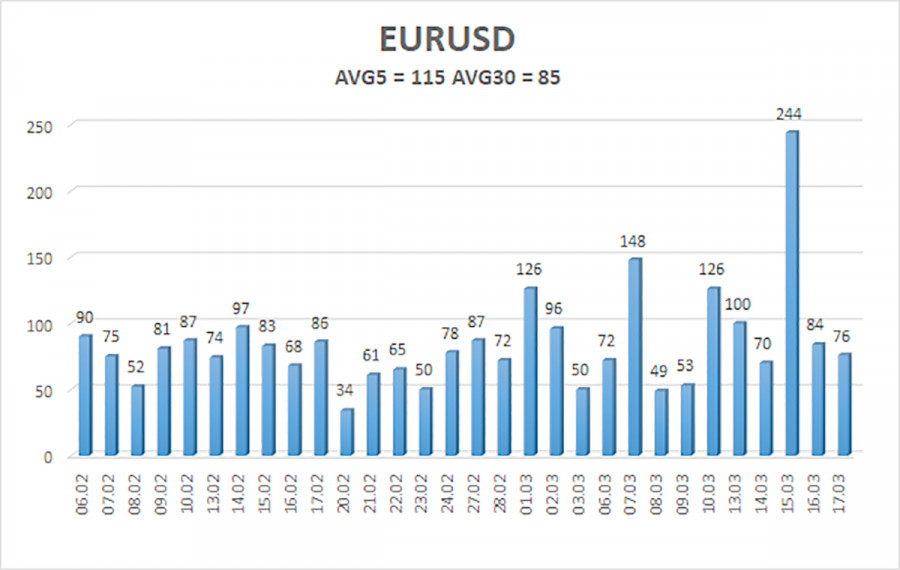
The EUR/USD currency pair traded in the same manner on Friday as it had been doing for several weeks. In general, the pair still cannot agree on the direction of movement despite the availability of recent fundamental and macroeconomic events; thus, we have either a flat or a "swing" on nearly all relevant timeframes. In general, the pair is now focused on increasing the amplitude of the swing, as practically every subsequent turn is stronger than the one before it. Now, we can anticipate growth up to the Murray level of "0/8"-1.0742 and possibly even a little higher, followed by another wave of declines to the area of 1.0500. When this mode of movement will stop is still a mystery.
In actuality, there were quite a few significant publications and planned and unplanned events last week. Also, there were reports on inflation, an ECB meeting, bank failures in the United States, and issues with a significant European bank. All of this resulted in rather substantial fluctuations, but it did not help the pair resume its trend movement. However, the technical picture is currently extremely unclear, even on the 24-hour TF, where the price is close to the Senkou Span B line and has already exceeded the key line multiple times. Hence, legally, the downward correction is still ongoing, but in reality, the daily TF shows a flat line.
The following week will be filled with a variety of intriguing events, and traders will be closely watching Lagarde's statements or the outcome of the Fed meeting. The likelihood that the pair will be able to quit swaying from side to side as a result of these events is far from certain. It frequently occurs that the foundation and macroeconomics seem to disappear during a flat or "swing" period.
Again, Lagarde's tone is expected to become more aggressive.
This time, there won't be a swing to start the week. ECB President Christine Lagarde will speak twice simultaneously on Monday. Although the speech is different, last week saw the release of another report on EU inflation as well as the ECB meeting, during which Lagarde, incidentally, did not communicate with the markets openly and honestly. The latest inflation report revealed a minor yearly decline of 0.1%. It was at this point that the indicator started to slow down after three months of a very quick decrease. Perhaps it will be similar to the United States, where a weak January fall was followed by a strong February fall. So, it is too early to sound the alarm now. At least the March inflation value will be made public before the May ECB meeting, making it feasible to determine if the February result was an accident or the start of a downward trend. The ECB has signaled to the market that it is no longer willing to continue raising the rate by a fixed amount at each meeting, therefore, it will be very terrible for the euro if inflation slows down further in its decline. The strategy of "reacting to macroeconomic data" will be applied from now on. The macroeconomic data also include indicators of the overall health of the EU economy, not just inflation. Additionally, the ECB might be forced to raise rates at a rate of no more than 0.25% if important macroeconomic indicators continue to decline or remain in an unacceptable state. However, keep in mind that Credit Suisse bank is in a precarious situation and that it might not be the only bank to start having issues in the near future.
Tuesday and Wednesday will each include further speeches from Christine Lagarde. The following macroeconomic articles, however, are expected as soon as this Friday. The Markit business activity indices for the manufacturing and service sectors will be available on this day. All three indices have been increasing recently, except for the manufacturing sector, which is still weak and is below the "waterline" of 50.0. We should also keep in mind that these are leading indications of the state of the economy. If these indices are rising, the economy ought to develop, not contract. Yet, these reports by themselves are not likely to have a significant impact on the market. Also, notwithstanding Christine Lagarde's four speeches, the ECB president may be able to ignore the traders' request for more information regarding the rate.

As of March 20, the euro/dollar currency pair's average volatility over the previous five trading days was 115 points, which is considered to be "high." Hence, on Monday, we anticipate the pair to move between 1.0552 and 1.0782. A new round of downward movement within the "swing" will be indicated by the Heiken Ashi indicator turning back down.
Nearest levels of support
S1 – 1.0620
S2 – 1.0498
Nearest levels of resistance
R1 – 1.0742
R2 – 1.0864
R3 – 1.0986
Trade Suggestions:
The EUR/USD pair is presently above the moving average and has once again changed direction. Until the Heiken Ashi indicator turns down, you can continue holding long positions with targets of 1.0742 and 1.0782. If the price is fixed below the moving average line, short positions can be initiated with targets of 1.0552 and 1.0498.
Explanations for the illustrations:
Channels for linear regression - allow us to identify the present trend. The trend is now strong if they are both moving in the same direction.
Moving average line (settings 20.0, smoothed): This indicator identifies the current short-term trend and the trading direction.
Murray levels serve as the starting point for adjustments and movements.
Based on current volatility indicators, volatility levels (red lines) represent the expected price channel in which the pair will trade the following day.
A trend reversal in the opposite direction is imminent when the CCI indicator crosses into the overbought (above +250) or oversold (below -250) zones.
The material has been provided by InstaForex Company - www.instaforex.comfrom Forex analysis review https://ift.tt/0ZMxEkw
via IFTTT
